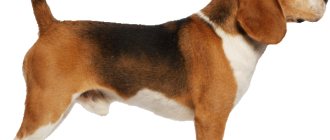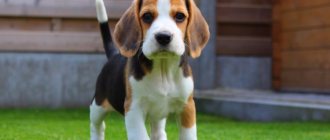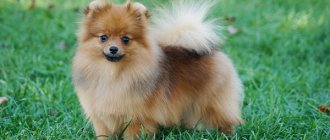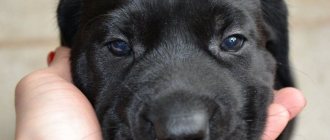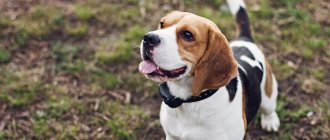Beagles are British hunting dogs with a rich history.Yu. Their main qualities are speed (surprisingly, because the legs of these animals are short), activity and courage.
They are not easy to train due to the restlessness inherent in the gene pool, but at the same time they have plenty of devotion and intelligence. Their keen sense of smell makes beagles one of the most ideal dogs in the world and therefore they are used for service purposes.
Despite their inherent activity, animals cope well with the role of family pets and treat household members with kindness and love. Perhaps this unique versatility contributes to the popularity of the breed.
Note: Beagles are the patrons of children and the best friends for people of all ages. They gained such fame thanks to the character from the famous Peanuts comics Snoopy. Artist Charles Schulz created a "worldwide association of the breed" that reads: "The Beagle is a magnificent hound and a kind dog with an extremely intelligent and penetrating eye."
Breed varieties
Beagles are divided into two subspecies:
- European;
- American.
"Europeans" are smaller in size compared to "Americans". They are small, active and cheerful.
Other subspecies of the breed in question are the French Beagle Harrier, the English Beagle and the Irish Kerry. Next, let's look at the different colors of Beagle dogs. Photos will help you form an opinion about these beauties if you are unfamiliar with representatives of this family.
Video “What do we know about the beagle”
From this video you will learn about all the benefits of the funny Beagle breed.
Recommended Posts
The most popular and rare Chihuahua colors
The most popular and very rare Spitz colors
Common and rarest colors of the French Bulldog
All about the breed and buying a pocket mini Chihuahua
The main differences between the Estonian hound and the beagle
What color can Scottish Fold cats be?
French beagle harrier
This is a hound dog from France. It appeared in the 19th century and was created specifically for hunting.
These beagles have strong bones, weight up to 20 kg, height - up to 48 cm at the withers.
The color may vary, but is always registered for hounds. The standard color is the tricolor, representing a composition of black, white and red. The standards also allow less bright representatives, with gray and dull tones. Experts do not disqualify such dogs from exhibitions.
The fur fits tightly to the body, which makes it easy to care for.
These dogs are friendly and welcoming. They do not often participate in exhibitions, but are perfect for living at home.
Maintenance and care
Beagles can be kept either in an apartment or a private house, or in an outdoor enclosure.
It must be remembered that these dogs are sensitive to low temperatures, so the enclosure must be insulated, and when walking in the cold season, the pet needs warm clothes.
Wool and bathing
Smooth-haired beagles do not require careful grooming and frequent washing.
These dogs should be bathed no more than once a quarter, using special shampoos, and brushed several times a week with a special glove or brush, and during shedding, with a furminator.
Ears
Beagles have floppy ears that fit tightly to the head, which are poorly ventilated, which creates a favorable atmosphere for the development of infection.
It is necessary to wipe your pet's ears weekly with a cotton pad soaked in a special lotion.
If you notice inflammation, an unpleasant odor, or if your pet is shaking its head, you should immediately show it to a veterinarian.
Eyes, teeth and claws
The eyes are one of the weak points of beagles, so they need to be wiped daily with an antimicrobial agent.
The dog's teeth should be brushed once a week with a special toothbrush and toothpaste.
The claws usually wear down on their own during walks. If this does not happen, then you should trim them using a guillotine nail clipper.
NOTE!
It is necessary to regularly carry out deworming and treatment for external parasites.
English beagle
This type of breed was developed in Britain. Mentions of such dogs date back to the 4th century BC. e. They hunted hares at the courts of Edward II and Henry VIII.
These days, dogs of this breed are kept as companions and friendly pets.
Among the colors of English hounds there are “bicolors” and “tricolors”. Their main color is white, combined with red and black. Dogs reach a weight of 14 kg, their height at the withers is up to 40 cm.
Puppies
A newborn beagle weighs 250-450 g. The puppies are still absolutely helpless. But in the first month they are completely transformed - they stand on their feet, open their eyes, and show genuine interest in the world around them.
During the period of active growth, dogs especially need balanced food. The little beagle, which is not yet a month old, feeds exclusively on its mother's milk. Then they begin to introduce complementary foods. At this time, food is given 6 times a day at regular intervals.
Gradually new products are introduced into the diet:
- Beagle: 2 months - the baby is fed the same way as the breeder did. As a rule, he is given finely chopped beef, vegetable purees, cottage cheese and milk.
- Beagle: 3 months – puppies are given porridge (oatmeal, buckwheat, rice). The meat is cut into larger pieces so that the pet can chew them easily. As they grow older, they include offal. The number of feedings is reduced to 5.
- Beagle: 6 months – It is useful for puppies to gnaw on marrow bones while changing their teeth. A couple of times a week they prepare porridge with sea fish, and continue to give them fermented milk products to replenish calcium reserves in the body. In consultation with the veterinarian, vitamin and mineral complexes are selected. Feeding frequency – 4 times a day.
From six months to a year, the animal is fed 3 times a day, the diet is as close as possible to that of an adult. The puppy should look moderately well-fed, but not fat. An adult beagle eats 2 times a day. Using the table below, you can track the correct development of your beagle dog by month.
| Age | Height | Weight |
| 1 month | 18-20 cm | 1.5-2 kg |
| 2 months | 22-25 cm | 3-4 kg |
| 3 months | 28-30 cm | 5-6 kg |
| 4 months | 30-32 cm | 7-8 kg |
| 5 months | 32-34 cm | 8-10 kg |
| 6 months | 33-35 cm | 9-11 kg |
| 7 months | 35-37 cm | 11-13 kg |
| 8 months | 36-37.3 cm | 12-14 kg |
| 9 months | 36.4-37.5 cm | 13-15 kg |
| 10 months | 37-38 cm | 14-16 kg |
| 11 months | 38-39 cm | 15-17 kg |
| 12 months | 38-40 cm | 16-18 kg |
Growing up passes very quickly - within a year the beagle grows to the size of an adult dog.
Irish Kerry
The breed was bred in the 16th century in Ireland for hunting hares. The dog reaches a height of 55 cm and a weight of 27 kg.
The typical color is saddleback, but spotted and tricolor are also available.
Kerrys tolerate physical activity very well, they are fast and agile. They have excellent hunting skills, but easily serve as pets.
Purpose
The hound dog was bred for hunting. The dog was allowed to hunt hares and large animals. The beagle smelled prey and chased it across the fields. By barking, the assistant reported the location of the hare.
By the 21st century, England had banned the use of dogs to track rabbits without the permission of the landowner. Beagles are also used to identify prohibitive means in research and experiments.
Today the beagle can be a companion. But the dog's hunting instinct is highly developed. Pets need long walks and daily games. Out of boredom, the dog will begin to take out energy on things in the house. A sedentary lifestyle leads to obesity in dogs.
Expert opinion
Anna Abramenko
An avid dog lover. Experience in veterinary medicine since 2009.
Ask a Question
A good hound can chase its prey for several hours without stopping. A beagle travels up to 120 km per day. This dog is not a couch pet.
American Beagle
In 1870, beagles were brought to America. Local breeders tried to change the appearance of the dogs, but not very successfully.
Later, General Richard Rowett assembled his pack of beagles, consisting mainly of "British". Gradually, hounds spread throughout America. They are more impressive in size than the “Europeans”.
Let's look at the possible colors of the beagle.
Lifespan
A beagle lives 12-15 years - average for individuals of this size. The period may change due to external factors and heredity. Excess weight has a negative impact on the life expectancy of dogs. Pets eat without restriction. It is important for owners to control the amount of energy consumed.
Beagles often contract diseases such as boils, glaucoma, cataracts, and ear infections. Your dog's hearing organs require care because they are poorly ventilated.
Accepted color standards
According to the FCI standard, any hound color is acceptable for beagles, with the exception of “liver,” that is, chocolate. The British Kennel Club adhered to the same opinion, allowing any hound color for the beagle, but without removing “liver” (brown) from this list. Beagle breeders from all over the world often wonder what exactly the acceptable color of hounds is.
Some dog breeders understand by this expression the color found in pack hounds, for example, in English and American Foxhounds, Basset Hounds, and Harriers. However, pack hounds such as coonhounds have completely different colors - brindle. And wire-haired hounds, such as the Otterhound and the Vendeen Basset Griffon, often have graying hair, and this option is not at all similar to the Beagle's coat.
To clarify, the British Kennel Club adopted a new edition of the standard in 2010, which listed all possible colors for a beagle with the caveat that all other options are unacceptable.
Let's imagine the colors that beagles have. Some of them are rare, but nevertheless allowed by the breed standard.
Most dog lovers, when imagining a beagle, imagine a tri-colored black, red and white dog. This option is truly the most common in the breed and is a classic. Such a dog has a black back, a red head, and a white body, muzzle, chest, legs and tip of the tail.
But this classic beagle color is not the only one that dogs have. There are many other options. It is not possible to single out a more or less correct beagle color among them, since all breeders are of the opinion that all hound color options are good in their own way.
Experts identify several basic colors:
- two-color, otherwise called bicolor;
- tricolor - tricolor;
- weakened - muted;
- spotted - motley.
Required elements
Despite the huge variation in colors, Beagles are allowed to have a certain number of colors. These include black, white, red, brown and all their shades. The arrangement of tones is not regulated by canine associations. They do not prioritize colors, allowing all possible options characteristic of hound breeds. Most organizations consider only one color to be wrong - liver (or chocolate).
The only constant elements of each suit are the white tip of the tail and the possibility of having specks (except pure white). Other colors are not allowed at all, as is directly stated in the breed standards.
Bicolor
The color can also be called red and white. The two-tone color is expressed by red shades of pigment and white. In turn, red tones, depending on their saturation, can be called red, red or lemon. At birth, Beagle puppies have cream or fawn markings, which darken as they grow. "Schisandra" are almost white, their nose is dark.
Light red and white color - lighter than true red and white. Often these puppies darken with age. Bicolors can grow red-and-white, or they can grow lemon-white.
The pigment of the nose is usually darker in light-colored dogs. The initially light lobe may darken with age, and its color in females also changes depending on the hormonal period.
Tricolor
Black, red and white beagles are more common than other colors. Their puppies are black and white at birth (there may be brown markings around the ears and eyes), with red appearing as the puppies grow. Black can be bright throughout life, or it can fade and become paler. Red ranges from red to fawn. The white is always pure white, although in speckled dogs it is closer to cream. The tip of the nose and the rim of the eyelids are black.
Sometimes puppies of this color variety, after reaching 6-8 weeks, develop white hairs on their black backs - “overhairs”. They usually disappear after some time.
Blue tricolor
There is also another version of the tricolor color, the so-called weakened tricolor. The color weakening gene is responsible for the appearance of a blue tint - it looks more like gray, and also lightens the red to a light brown tone. At birth, puppies are gray and white.
The beagle's eyes are light blue, almost yellow, and its nose is dark gray, slate. At a younger age, this is sometimes the only sign by which they are distinguished from representatives of the classic tricolor.
Health and major diseases
Beagles have fairly good health, but there are a number of diseases to which these dogs are prone:
- epilepsy is a disease accompanied by characteristic seizures; it can be hereditary or develop due to excessive stress on the nervous system or difficult childbirth;
- hypothyroidism – a disorder in the production of certain thyroid hormones, leading to weight gain, deterioration of coat condition, and problems with the reproductive organs;
- “cherry eye” or third eyelid adenoma - prolapse of the third eyelid gland due to its weak attachment to the lower rim of the eye;
- glaucoma is a disease in which intraocular pressure increases;
- cataract – characterized by clouding of the lens of the eye;
- iris dysplasia – a disease leading to blindness;
- intervertebral hernia is a violation of the geometry and structure of the vertebrae, causing pain in the spine.
Less common diseases are:
- diabetes;
- chronic hepatitis;
- lymphoma;
- dermatitis;
- hypotrichosis;
- deafness;
- amyloidosis;
- Cushing's syndrome;
- mast cell cancer;
- cryptorchidism and monorchidism;
- ear infections.
Preventive examinations carried out twice a year will allow you to detect the disease at an early stage of development and begin treatment on time.
Chocolate tricolor
Among the “liver” tricolor colors, the black gene will produce brown. Chocolate beagles have gray-green eyes, and the nose, lips and eyelids are brown, and their shades can be different: dark chocolate, light brown, liver, lilac.
This color was not recognized by the British Kennel Club and the FCI. If such puppies are born, they are considered a breeding match. But, for example, in the USA, chocolate beagles are officially registered and show the highest results in the rings.
Chocolate puppies with gray-green eyes may become darker with age and their eyes may become hazel. It also happens that a lilac dog, in addition to the weakening brown, also has blue, and then the fur acquires a bluish tint.
Attitude towards pets and children
Beagles simply adore children. Such a dog will happily play with the child, sharing his curiosity. If the baby has not yet reached primary school age, he may accidentally harm the dog, but a good-natured beagle will endure everything without showing aggression.
The lack of dominance and innate friendliness allows them to easily get along with other dogs and more. Difficulties can only arise with cats and rodents in the same house - the pet may mistake them for prey, but if the dog is initially raised correctly, problems will not arise and the beagle will find a common language with them.
Mottled color
Both 2-color and 3-color beagles often have small black or tan spots on a white background, they can be located far or close to each other. The spots appear at 6-8 weeks of a puppy's life and gradually become denser. True speckled puppies acquire this color as early as four days of age, this can be determined by the pigmentation on the paw pads - they are not pink, like other beagles.
Speckled dogs rarely appear in the show ring. This coloring is inherent in working beagles, and they do not take it as a defect in the breed.
Distinctive features
Of course, it’s worth knowing them to be sure of his thoroughbred:
- Firstly, the dog must have a beautiful head: big eyes, clear gaze.
- As noted earlier, the body structure is necessarily athletic.
- Also a characteristic distinguishing feature is the black border around the eyes.
- It is also important to pay attention to the character of the dog, because thoroughbred is determined not only by appearance. One of the qualities of the breed is its friendliness. A Beagle can definitely be a wonderful companion for you. In addition, they are unpretentious: they do not need a lot of space, they will not run and rush around the house, having fun only on the street. But this breed loves walks because it needs movement, because it is a hunter.
But there is also a big minus in the character of beagles - his manners.
Raising a beagle is not easy because they are very naughty..
This is evidenced by the fact that the breed is at the bottom of the list of dog trainability. Therefore, you definitely need to keep an eye on your beagle during a walk.
A dog can easily get lost because it will play or run away. And she most likely will not respond to the call. So think carefully about whether you can handle such a dog.
You should also pay attention to the fact that he does not like loneliness . But this can be solved: you can get a second dog like this, then they won’t get bored together.
Variegated color
This is the most controversial beagle coat color. There are three options:
- hare-motley;
- badger-pied - the darkest;
- lemon variegated - the lightest.
The area of distribution of “variegation” can be limited to a dark stripe on the back or spread over the entire colored part of the body.
Dogs of this color variety are most often found in the UK. Only in this country is this color of the beagle the breed standard. But motley dogs are also found in other countries. Some of the “faded” tricolors, upon closer examination, may well turn out to be variegated.
Breeders still do not have a consensus on what color of the Beagle breed is considered motley. Some consider this to be the partial coloring of black or red hairs, the tips of which become black, and the rest is red. Others are of the opinion that a variegated color is one in which black and red hairs are mixed in the animal's hair.
The main difference between these beagle colors and others is that the white color in this case is never pure white, but rather creamy, light cream. Colored spots are formed by mixing black, red and gray colors. Moreover, badger-motley dogs have more black hairs, while hare-motley dogs have less black hairs, but more red ones. There are no clear boundaries between the white and colored zones; the color smoothly flows into white and mixes with it.
The motley hare is found more often than others. It has a creamy background and the shades blend gently into each other. This is the difference between hare motley and blue and any “faded” tricolor.
In the lemon-variegated version, red and light cream backgrounds are mixed. A beagle of this color may appear solid and almost white.
The Pied Beagle is recognized by its typical nose color - it has dark edges and a light nose.
Variegated puppies are perceived as red and white, sometimes with a stripe of a darker shade on the ridge; dark eyeliner around the eyes is required.
Size
The breed acquired the name “beagle” because of its small size, because it is not for nothing that the word Begle from ancient English is translated as “small”.
Standard
According to the current standard, beagles should be small in size (male: 36–41 cm and female: 33–38 cm). The head of animals is in clear proportions and regular shape. The bump on the back of the head is pronounced, but not massive. The forehead is round and voluminous, and its length from the back of the head to the transition is extremely equal to the length of the face.
In turn, the front part, as well as the forehead, has no folds. The lips emphasize the shape of the head and are not loose, thick or saggy. Teeth without noticeable defects, strong and erect. The nose is wide, preference is given to black.
Representatives of beagles with light coat color are allowed a brown nose, but the complete absence of pigment on it (pink or cream color) is regarded as a clear fault. The ears are soft, the ends are necessarily rounded, reaching the tip of the nose in length. The eyes should have a friendly and expressive look, with a color ranging from brown to hazel or amber.
Body size - considers the proportionality of the sternum in relation to height. While the dog is searching, folds of skin are clearly visible in the neck area, and when running, the nose is directed towards ground level, but the neck is in a slight bend. The paws are often round in shape, the toes are clearly bent, their pads are soft and covered with a thick layer of skin, and the claws are short. The beagle's tail should be strong and stand vertical to the ground, without bends or any defects, even, with a white tip. When at rest, it lies along the line of the back; when moving, it is in the “up” position, without bending into a ring.
Anything that differs from the current breed standard is considered to be a defect and vice.
Are there black beagles?
This question is often asked by lovers of these beautiful dogs. Beagles' fur can be black, but it must be combined with other colors - for example, white or red. There are no pure black representatives of the breed, unlike white ones.
Black and white puppies are born infrequently. At birth they have brown spots around their ears and eyes. The white shade is closer to cream. Black can remain so throughout life, or it can fade over time.
Beagles have a really varied range of colors. In newborn puppies, color cannot always be determined accurately, and in adult dogs it often changes throughout life. Therefore, in order to avoid confusion, they adopted the official division into two-color and three-color. This is exactly how the color of beagle dogs is recorded in the pedigree.
All varieties of the considered breed share the same qualities - excellent hunting instincts, friendliness, cheerfulness, and lack of conflict. When choosing a puppy, you should pay attention and compare it with the breed standards. After all, if you purchase a dog that does not meet the prescribed parameters, such four-legged animals may lack hunting abilities and other qualities inherent in true beagles.
Advantages and disadvantages
In addition to their pretty appearance and cheerful disposition, beagles have other advantages:
- lack of aggression;
- friendliness;
- love for children;
- devotion;
- energy and endurance;
- cleanliness;
- lack of salivation and specific odor;
- ease of care;
- almost imperceptibly flowing molt.
Disadvantages of beagles:
- intolerance of loneliness;
- aggressive and inappropriate behavior in the absence of the owner’s attention;
- stubbornness;
- inability to concentrate on one action;
- cunning;
- excessive gullibility;
- lack of watchdog and security qualities;
- tendency to corpulence.
The big disadvantage of this breed is the difficulty of training, and without it the dog becomes uncontrollable, and many advantages turn into disadvantages.

